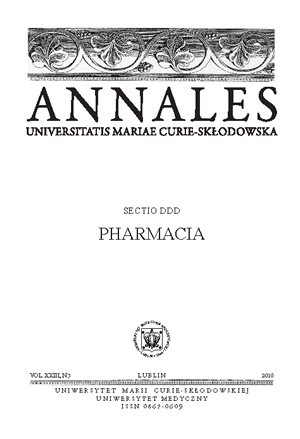Amikacin-modified hybrid biomaterial biological properties
Keywords:
hydroxyapatite, amikacin, antibiotic immobilization, implant infection, cytotoxicityAbstract
Hydroxyapatite is used in bone reconstruction because of its similar chemical structure compared to the inorganic composition of human bone. Bone is a complex material composed of proteins, mainly collagen, with hydroxyapatite. Therefore, now many investigations are focused on the hybrid biomaterials of hydroxyapatite with proteins and other synthetic polymers. We investigated HAp granules covered by two types of proteins (keratin or gelatin) in our study. This biomaterial was also modified by amikacin. In our previous paper (12) we proved that such hybrid biomaterial had antimicrobial properties. This paper gives evidence that HAp-modified granules did not influence on growth and proliferation of osteoblasts. So this new biomaterial could be used as an implant on orthopaedic, oral and maxillo-facial surgery in the future.
References
1. Bareille R., Lafage-Proust M. H., Faucheux C., Laroche N., Wenz R., Dard M., Amédée J.: Various evaluation techniques of newly formed bone in porous hydroxyapatite loaded with human bone marrow cells implanted in an extra-osseous site. Biomaterials, 21(13), 1345-1352, 2000.
2. den Boer F., Wippermann B., Blohuis T., Patka P., Bakker F., Haarman H.: Healing of segmental bone defect with granular porous hydroxyapatite augmented with recombinant human osteogenic protein-1 or autologous bone marrow.
J. Orthop. Res., 21(3), 521-528, 2003.
3. Gille J., Dorn B., Kekow J., Bruns J., Behrens P.: Bone substitutes as carriers for transforming growth factor-beta(1) [TGF-beta(1)]. Int Orthop., 26 (4), 203-206, 2002
4. Ginalska G., Uryniak A., Łobarzewski J., Osińska M. Immobilization method of antibiotics contain primary amino groups on solid matrices covered by protein. Polish Patent no P-201383, 2009
5. Ginalska G., Kowalczuk D., Osińska M. Amikacin-loaded vascular prothesis as an effective drug carrier. Int. J. Pharmaceut., 339 (1-2), 39-46, 2007
6. Krisanapiboon A., Buranapanitkit B., Oungbho K.. Biocompability of hydroxyapatite composite as a local drug delivery system. J. Orthop. Surg. 14 (3), 315-318, 2006
7. Oonish H. Orthopaedic applications of hydroxyapatite. Biomaterials, 12, 171-178, 1991
8. Rauschmann M. A., Wichelhaus T.A., Stirnal V., Dingeldein E., Zichner L., Schnettler R., Alt V. Nanocrystalline hydroxyapatite and calcium sulphate as biodegradable composite carrier material for local delivery of antibiotics in bone infections. Biomaterials, 26 (15) 2677-2684, 2005
9. Sudo A., Hasegawa M., Fukuda A., Uchida A. Treatment of infected hip arthroplasty with antibiotic-impregnated calcium hydroxyapatite. J Arthroplasty., 23 (1),145-150, 2008
10. Tachibana A., Kaneko S., Tanabe T., Yamauchi K. Rapid fabrication of keratin-hydroxyapatite sponges toward osteoblast cultivation and differentiation. Biomaterials, 26 (3), 297-302, 2005
11. Weetall H.H. Covalent coupling methods for inorganic support materials. Methods Enzymol., 44, 134-148, 1976
12. Zalewska J., Ginalska G. Amikacin modified hybrid biomaterial antimicrobial properties. Annales UMCS, sect. DDD, 22 (2), 39-45, 2009
Downloads
Published
Issue
Section
License
Copyright (c) 2010 Authors

This work is licensed under a Creative Commons Attribution-NonCommercial-NoDerivatives 3.0 Unported License.


